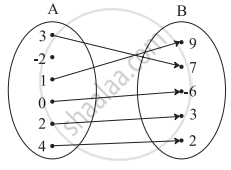Advertisements
Advertisements
प्रश्न
Let f and g be two functions given by
f = {(2, 4), (5, 6), (8, −1), (10, −3)} and g = {(2, 5), (7, 1), (8, 4), (10, 13), (11, −5)}.
Find the domain of f + g
उत्तर
It is given that f and g are two functions such that
f = {(2, 4), (5, 6), (8, −1), (10, −3)}
and g = {(2, 5), (7, 1), (8, 4), (10, 13), (11, −5)}
Now,
Domain of f = Df = {2, 5, 8, 10}
Domain of g = Dg = {2, 7, 8, 10, 11}
∴ Domain of f + g = Df ∩ Dg = {2, 8, 10}
APPEARS IN
संबंधित प्रश्न
Define a function as a correspondence between two sets.
f, g, h are three function defined from R to R as follow:
(i) f(x) = x2
Find the range of function.
If f : R → R be defined by f(x) = x2 + 1, then find f−1 [17] and f−1 [−3].
If \[f\left( x \right) = \frac{2x}{1 + x^2}\] , show that f(tan θ) = sin 2θ.
If\[f\left( x \right) = 1 - \frac{1}{x}\] , then write the value of \[f\left( f\left( \frac{1}{x} \right) \right)\]
Write the domain and range of function f(x) given by \[f\left( x \right) = \sqrt{\left[ x \right] - x}\] .
Find the set of values of x for which the functions f(x) = 3x2 − 1 and g(x) = 3 + x are equal.
Let f and g be two real functions given by
f = {(0, 1), (2, 0), (3, −4), (4, 2), (5, 1)} and g = {(1, 0), (2, 2), (3, −1), (4, 4), (5, 3)}
Find the domain of fg.
If f(x) = cos (log x), then the value of f(x) f(y) −\[\frac{1}{2}\left\{ f\left( \frac{x}{y} \right) + f\left( xy \right) \right\}\] is
Which of the following are functions?
If \[f\left( x \right) = \log \left( \frac{1 + x}{1 - x} \right)\] , then \[f\left( \frac{2x}{1 + x^2} \right)\] is equal to
If \[f\left( x \right) = \frac{\sin^4 x + \cos^2 x}{\sin^2 x + \cos^4 x}\] for x ∈ R, then f (2002) =
Let A = {x ∈ R : x ≠ 0, −4 ≤ x ≤ 4} and f : A ∈ R be defined by \[f\left( x \right) = \frac{\left| x \right|}{x}\] for x ∈ A. Then th (is
If f(x) = `{(x^2 + 3"," x ≤ 2),(5x + 7"," x > 2):},` then find f(0)
Check if the following relation is a function.

Check if the relation given by the equation represents y as function of x:
2x + 3y = 12
If f(x) = `("a" - x)/("b" - x)`, f(2) is undefined, and f(3) = 5, find a and b
Express the area A of circle as a function of its diameter d
lf f(x) = 3(4x+1), find f(– 3)
Express the following logarithmic equation in exponential form
In `1/2` = – 0.693
Solve for x.
x + log10 (1 + 2x) = x log10 5 + log10 6
Answer the following:
Find whether the following function is one-one
f : R − {3} → R defined by f(x) = `(5x + 7)/(x - 3)` for x ∈ R − {3}
A function f is defined as : f(x) = 5 – x for 0 ≤ x ≤ 4. Find the value of x such that f(x) = 3
Answer the following:
Let f : R → R be given by f(x) = x3 + 1 for all x ∈ R. Draw its graph
Answer the following:
Simplify `log_10 28/45 - log_10 35/324 + log_10 325/432 - log_10 13/15`
Answer the following:
If f(x) = log(1 – x), 0 ≤ x < 1 show that `"f"(1/(1 + x))` = f(1 – x) – f(– x)
Answer the following:
Without using log tables, prove that `2/5 < log_10 3 < 1/2`
Answer the following:
Find the domain of the following function.
f(x) = `sqrt(x - 3) + 1/(log(5 - x))`
Find the domain of the following function.
f(x) = `sqrtlog(x^2 - 6x + 6)`
Let X = {3, 4, 6, 8}. Determine whether the relation R = {(x, f(x)) | x ∈ X, f(x) = x2 + 1} is a function from X to N?
Given the function f: x → x2 – 5x + 6, evaluate f(x – 1)
A function f is defined by f(x) = 2x – 3 find x such that f(x) = 0
If the domain of function f(a) = a2 - 4a + 8 is (-∞, ∞), then the range of function is ______
The range of the function f(x) = `(x^2 - 3x + 2)/(x^3 - 4x^2 + 5x - 2)` is ______
Find the domain of the following functions given by f(x) = `1/sqrt(1 - cos x)`
Find the domain of the following functions given by f(x) = x|x|
Find the range of the following functions given by f(x) = `3/(2 - x^2)`
The domain and range of the function f given by f(x) = 2 – |x – 5| is ______.
